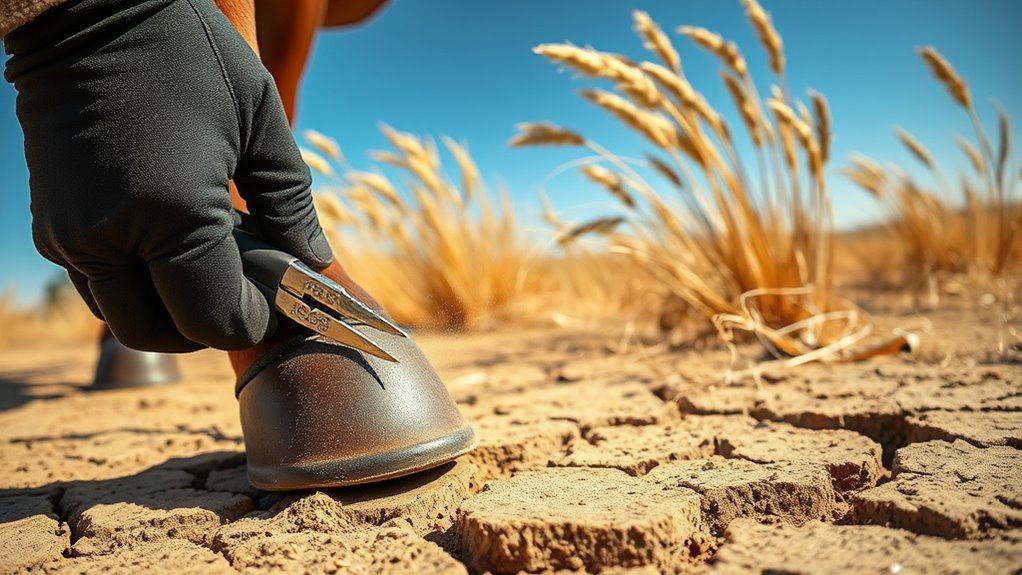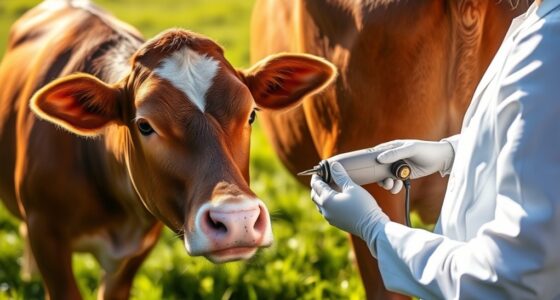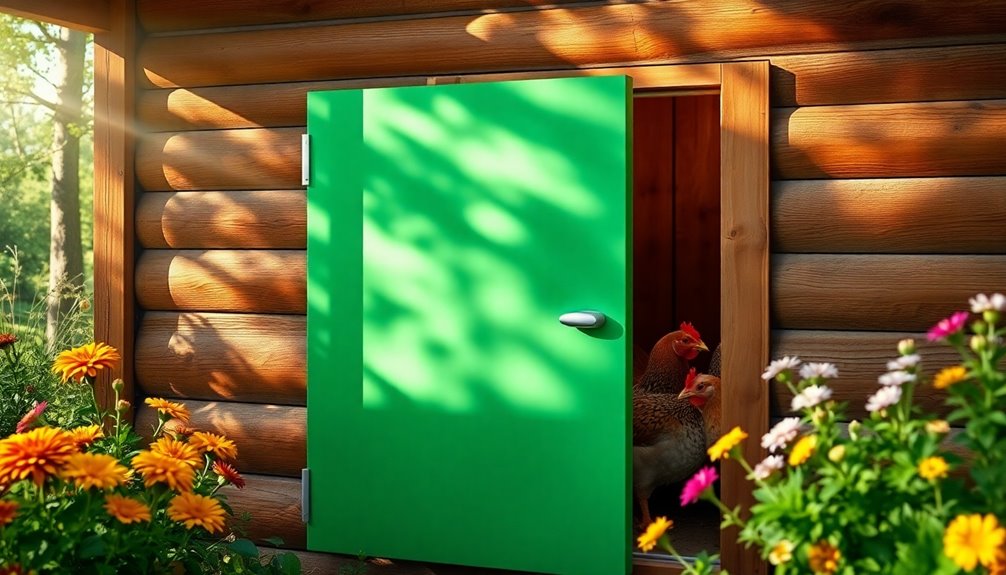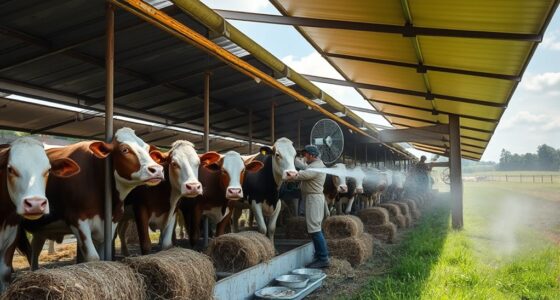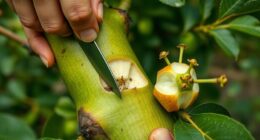In late July, focus on daily hoof cleaning to remove dirt and debris that can cause cracks and infections. Apply a natural moisturizer to keep hooves flexible and prevent dryness or cracking, especially in dry climates. Schedule your farrier visits every 6-8 weeks for trimming and shaping suited to summer conditions. Guarantee proper hydration and nutrition to support hoof health, and watch for early signs of damage to act quickly. For detailed tips, keep exploring these essential summer hoof care strategies.
Key Takeaways
- Increase hoof moisturization with natural oils like lanolin to prevent cracking in dry, hot conditions.
- Schedule trimming every 6-8 weeks, focusing on maintaining balanced hooves to minimize stress and uneven wear.
- Regularly inspect hooves for cracks, dryness, and dark spots, addressing issues early to prevent infections.
- Ensure proper hydration and a nutrient-rich diet, including biotin and zinc, to support hoof strength and resilience.
- Maintain stable environmental conditions with good ventilation and humidity control to reduce hoof dryness and promote healthy growth.
Assessing Hoof Condition in Hot, Dry Weather
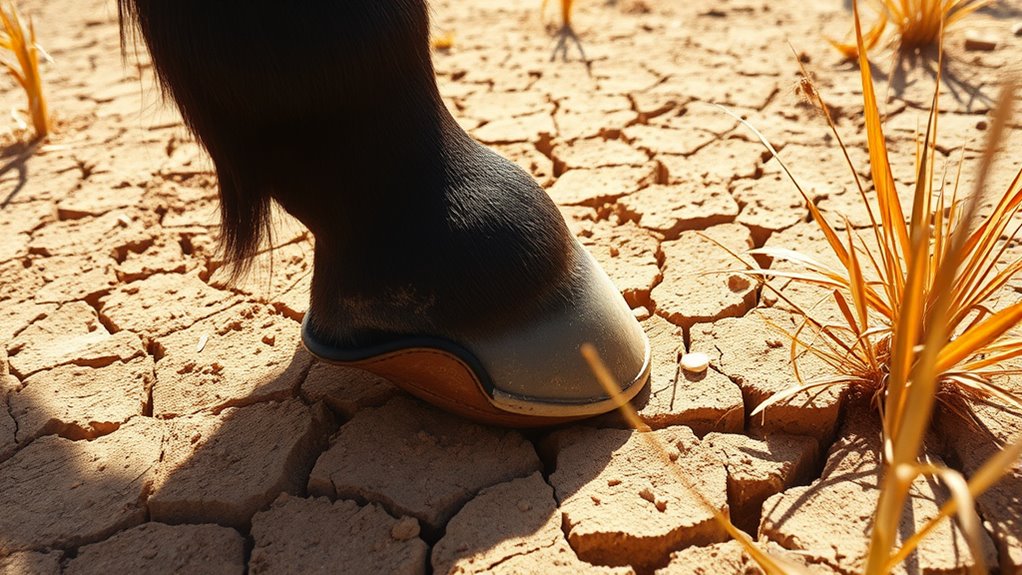
When the weather turns hot and dry, regularly evaluating your horse’s hooves becomes even more important. Check the hoof temperature frequently, as heat buildup can indicate inflammation or infection. Feel the hooves carefully to detect any unusual warmth compared to other hooves. Additionally, observe the hoof color for signs of issues like bruising or poor circulation. A healthy hoof should have a uniform, natural hue without dark spots or discoloration. Keep an eye on cracks or chips, which can worsen in dry conditions. By monitoring hoof temperature and color, you can catch early signs of trouble and address them promptly. Staying vigilant helps maintain healthy hooves and prevents complications caused by the stress of hot, dry weather. Regular inspections also support the development of AI-powered diagnostics, which are increasingly used to assess hoof health more accurately. Incorporating preventative care strategies can further protect your horse’s hooves during challenging weather conditions.
Implementing Daily Cleaning and Inspection
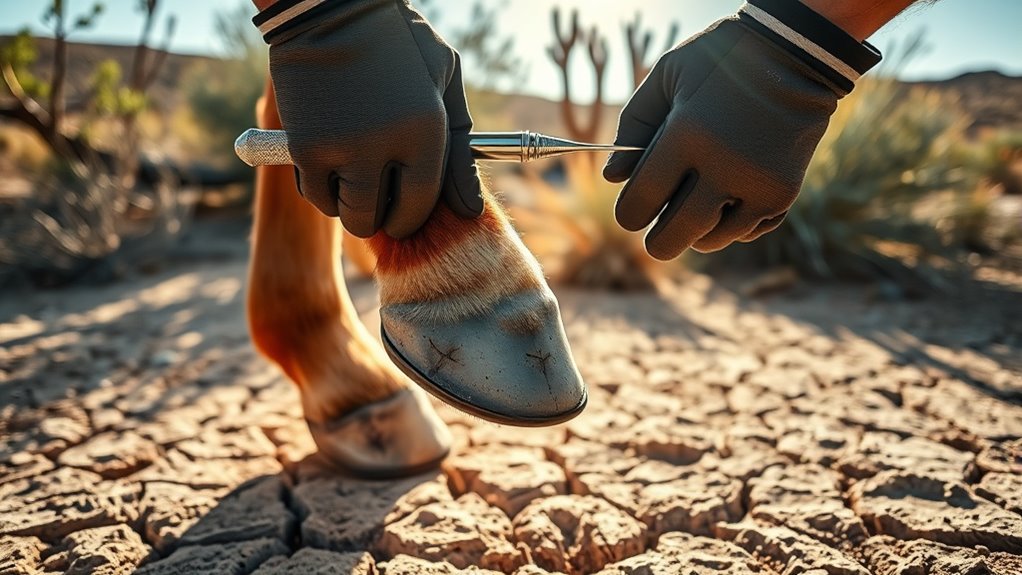
Daily cleaning and inspection are essential steps to maintaining your horse’s hoof health. By removing dirt, debris, and dried mud, you prevent bacteria buildup that can lead to infections or cracks. Use a hoof pick to carefully clean each hoof, paying close attention to the sole and frog. During inspection, look for any signs of damage, cracks, or uneven wear. Regularly check if your horse is due for hoof trimming, as overgrown hooves can cause discomfort and uneven gait. Keep a schedule for farrier visits to maintain proper hoof shape and health, especially in dry climates where hoof integrity can deteriorate quickly. Consistent cleaning and inspection help you catch potential issues early, ensuring your horse stays comfortable, healthy, and ready for regular hoof maintenance.
Applying Moisturizing Treatments to Prevent Cracking
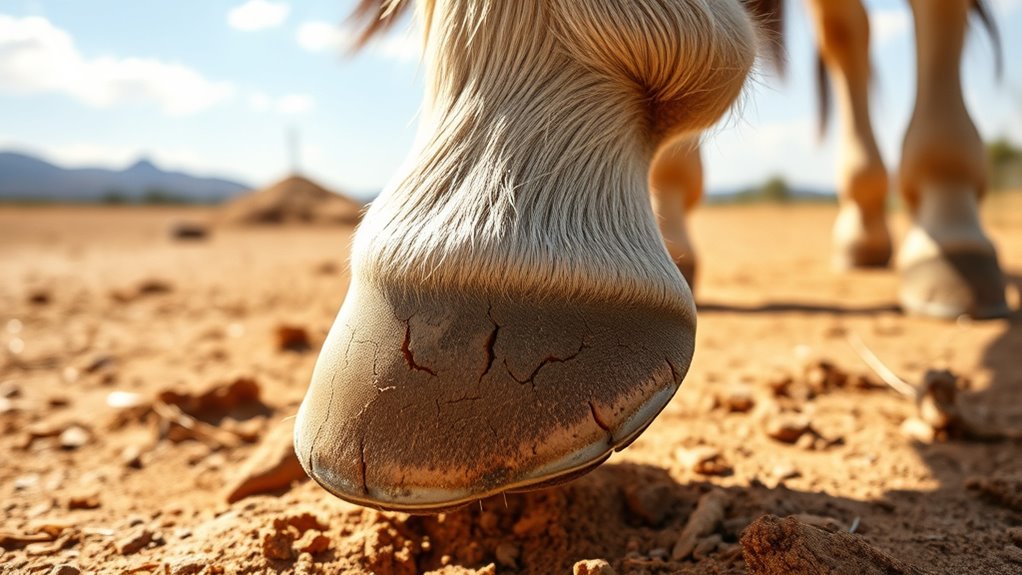
Choosing the right moisturizer is key to keeping your horse’s hooves healthy and crack-free. When you apply it, use proper techniques to guarantee even coverage and absorption. Keep an eye on your horse’s hooves regularly to spot any changes and adjust your treatment accordingly. Using a durable inlet strainer can help ensure your sprayer functions properly during application, leading to more consistent results. Regular inspection and maintenance of your sprayer can also prevent issues that may interfere with effective treatment.
Selecting Suitable Moisturizers
Selecting the right moisturizer is essential to keep your horse’s hooves healthy and prevent cracking. Look for products that promote ideal hoof growth and hydration, especially in dry climates. Choose moisturizers with natural oils like lanolin or vegetable-based ingredients, which penetrate deeply without causing buildup. Consider your horse’s specific needs, and consult your farrier for recommendations aligned with their techniques. Some moisturizers also contain conditioning agents that strengthen the hoof wall, reducing the risk of splits. Avoid products with harsh chemicals or excessive alcohol, as they can dry out hooves further. Regularly applying a suitable moisturizer maintains flexibility and resilience, supporting healthy hoof growth and preventing cracks caused by dehydration. Proper product selection ensures your horse’s hooves stay strong and well-hydrated in tough conditions. Incorporating natural oils can enhance absorption and effectiveness, providing long-lasting hydration. Additionally, understanding hoof health fundamentals can help you choose the most effective treatments for your horse’s specific environment and needs. Being aware of moisturizer ingredients can further aid in selecting products that truly benefit your horse’s hoof health. Staying informed about industry recommendations can also guide you toward the most trusted and effective options available.
Applying Techniques Effectively
To effectively apply moisturizing treatments and prevent cracking, it’s important to follow a consistent technique that guarantees even coverage and absorption. Begin by cleaning the hooves thoroughly to remove dirt and debris. When applying the moisturizer, use your fingers or a brush to spread it evenly over the entire hoof wall, paying attention to the coronary band and heel area. Proper hoof trimming ensures the hoof wall is balanced, allowing better absorption of the treatment. If your horse wears shoes, check that shoe fitting isn’t causing pressure points or cracks, and apply moisturizer around the edges to protect against dryness. Consistent application helps maintain hoof flexibility and resilience, reducing the risk of cracks. Regularly reviewing your technique ensures your horse’s hooves stay healthy in dry climates.
Monitoring Hoof Condition
How can you tell if your horse’s hooves are staying healthy and properly moisturized? Regular inspection is key. Look for signs like smooth, flexible hoof walls and even hoof discoloration, which can indicate good moisture levels. After hoof trimming, check for cracks or dryness that suggest the need for moisturizing treatments. Be alert to any changes in hoof color—darkening or chalky patches often signal dehydration or damage. Monitor for any flaking or splitting, especially in dry climates. Consistent observation helps catch issues early, allowing you to apply targeted moisturizing treatments to prevent cracking. Additionally, understanding the moisturizing treatments available can help you choose the best products to maintain hoof health. Maintaining this routine ensures your horse’s hooves stay strong, healthy, and resilient against environmental stressors.
Managing Hoof Moisture Levels Effectively
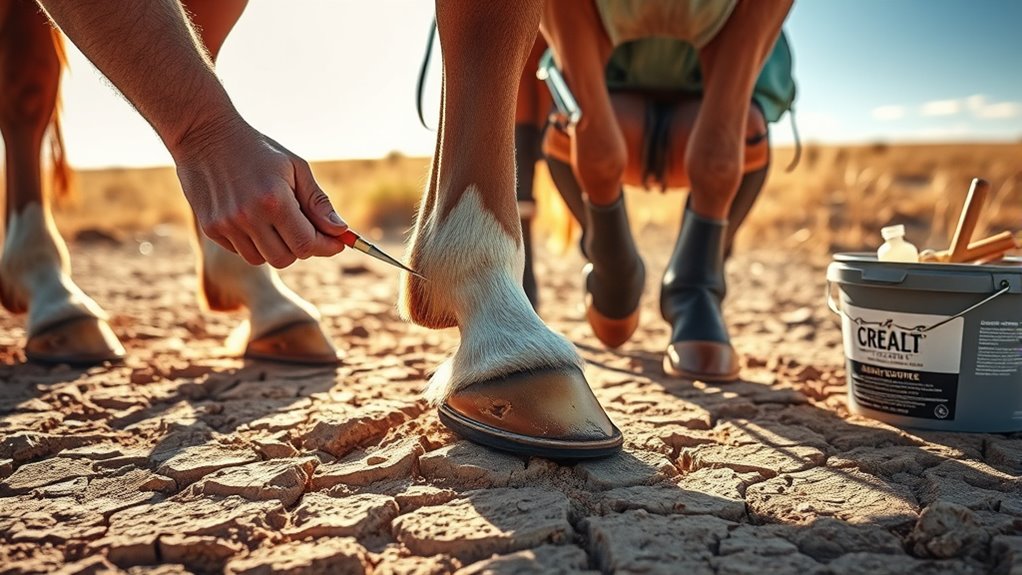
To keep your horse’s hooves healthy, you need to prevent them from becoming too dry or too moist. Balancing moisture content helps avoid cracks and other issues. By managing moisture levels effectively, you can support strong, resilient hooves. Engaging with community engagement can provide additional tips and support for maintaining optimal hoof health. Monitoring humidity levels and appropriate hoof care techniques can further enhance hoof strength and condition.
Preventing Excess Dryness
Managing hoof moisture levels is essential for preventing excess dryness, which can lead to cracks and brittleness. To do this, focus on maintaining proper hoof hydration by avoiding overly dry environments and using moisturizing products when needed. Regularly inspect your horse’s hooves for signs of dryness or cracking, and consider applying hoof conditioners that promote moisture retention. Ensuring good sole elasticity is also critical, as a supple sole helps absorb shock and prevents fractures. Avoid excessive trimming or exposure to harsh conditions that strip away natural oils. Instead, create a balanced environment that supports moisture retention while preventing excess dampness. Using sound design techniques can help create a calm and comfortable atmosphere around your horse, reducing stress that might impact hoof health. Keeping your horse’s hooves properly hydrated helps maintain strength, flexibility, and overall hoof health during dry seasons. Additionally, controlling ambient humidity levels around your horse can further prevent excess dryness and promote healthier hooves. Being aware of hoof environment factors can assist in creating optimal conditions for hoof health, including understanding how skincare ingredients like moisturizers contribute to hoof care.
Balancing Moisture Content
Achieving the right moisture balance in your horse’s hooves is essential for maintaining ideal health and durability. Proper hoof hydration ensures the hooves are neither too dry nor too soft, which can lead to cracks or infections. To manage moisture balance effectively, monitor your horse’s environment and adjust routines accordingly. In dry climates, avoid overexposing hooves to air, which can cause excessive dryness. You can apply hoof conditioners or oils to help retain moisture, but don’t overdo it—too much moisture can weaken the hoof structure. Regularly inspect hooves for signs of imbalance, such as cracking or excessive softness, and tailor your hoof care routine to maintain perfect hoof hydration. Understanding the importance of hoof moisture levels and their impact on hoof health will help you prevent long-term hoof problems and keep your horse comfortable. Additionally, maintaining an appropriate moisture content is crucial for preventing issues like splitting or softening, especially during the hot, dry summer months. Proper ventilation in your horse’s living area can also help regulate moisture levels and promote healthy hoof growth, reducing the risk of hoof problems caused by environmental fluctuations.
Selecting the Right Farrier Schedule for Summer Care
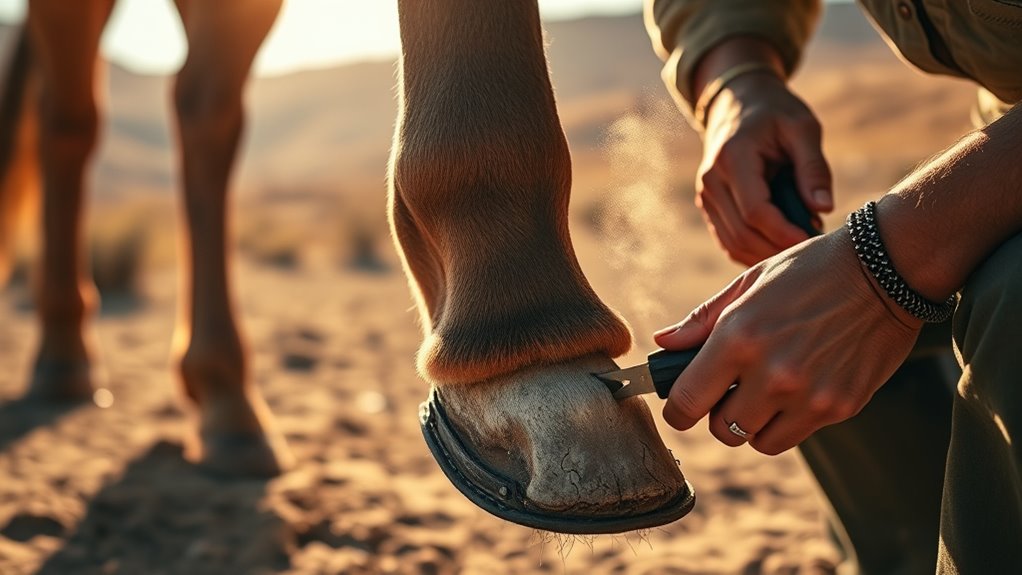
During summer, selecting the right farrier schedule is essential to keep your horse’s hooves healthy and comfortable in the hotter months. In dry climates, frequent hoof trimming helps prevent cracking and maintains ideal hoof shape. Regular shoe fitting ensures your horse remains comfortable and protected, especially if they wear shoes year-round. Adjusting the schedule based on activity level and hoof condition is key to avoiding over-trimming or delays that can cause issues. Keep an eye on your horse’s hooves for signs of dryness or splitting, and communicate with your farrier to determine the best intervals. Understanding hoof health and how it is affected by climate can guide you in scheduling appropriate care. Scheduling trims every 6-8 weeks for consistent hoof health is recommended, and seasonal changes can influence the necessary frequency of visits. Consider more frequent shoe fitting if your horse is active. Monitor for signs of hoof wear or damage between visits.
Enhancing Hoof Support With Proper Nutrition
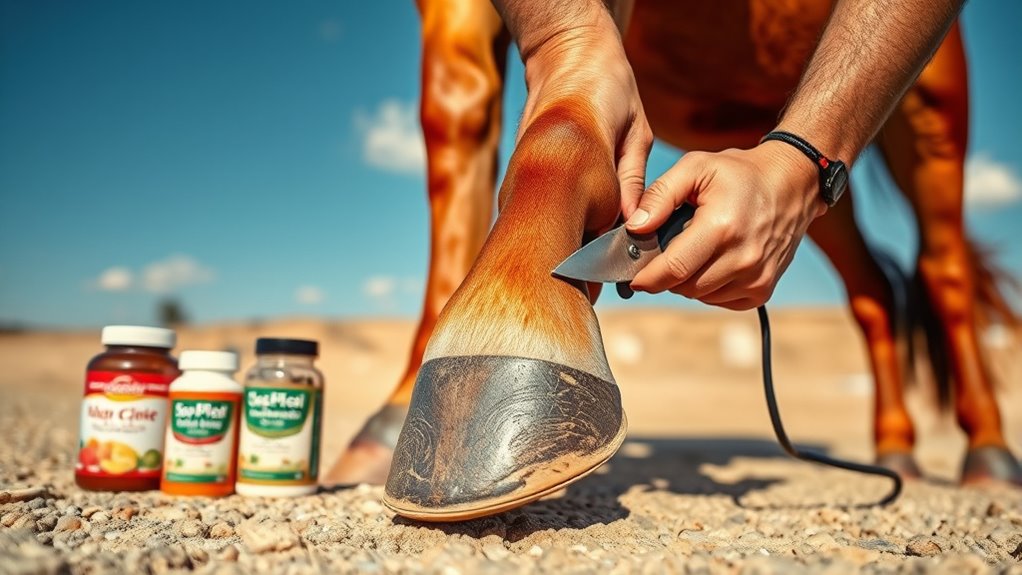
Proper nutrition plays a essential role in strengthening your horse’s hooves from the inside out. Focus on hoof nutrition by providing a balanced diet rich in essential nutrients. Minerals like biotin, zinc, and methionine are pivotal for healthy hoof growth and durability, especially in dry climates. Consider mineral supplementation if your forage lacks these necessary nutrients, ensuring your horse receives ideal support. Adequate protein and omega-3 fatty acids also promote strong, resilient hooves. Regularly review your horse’s diet with your veterinarian or equine nutritionist to identify any deficiencies. By prioritizing proper hoof nutrition, you help prevent dryness, cracking, and brittleness, supporting healthier hooves that can withstand the challenges of a dry environment. This proactive approach enhances your horse’s overall hoof health and longevity.
Recognizing Early Signs of Dryness and Damage
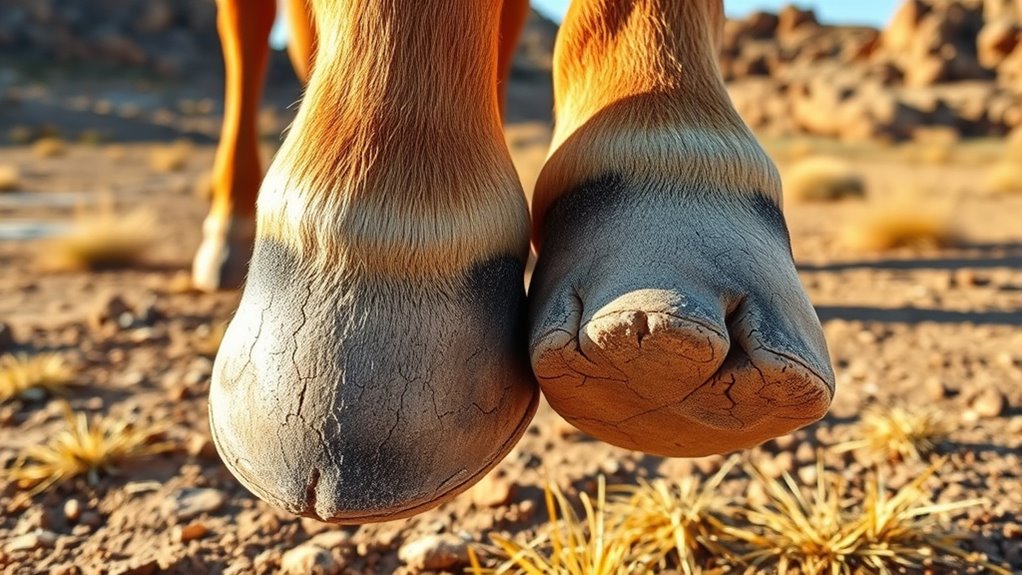
Early detection of dryness and damage in your horse’s hooves is essential for preventing more serious issues down the line. Keep a close eye on signs like cracks, chipping, or changes in hoof texture. Dry, brittle hooves are more prone to hoof infections and sole bruising, which can cause discomfort and lameness if left untreated. Regular inspections will help you catch problems early. Look for:
- Cracks or splits in the hoof wall
- Excessive flaking or peeling
- Unusual softness or dark spots indicating potential infections
If you notice any of these signs, address them promptly by consulting your farrier. Early intervention reduces the risk of infections spreading and prevents damage from worsening, keeping your horse comfortable and healthy.
Adjusting Turnout and Exercise Routines for Summer Conditions
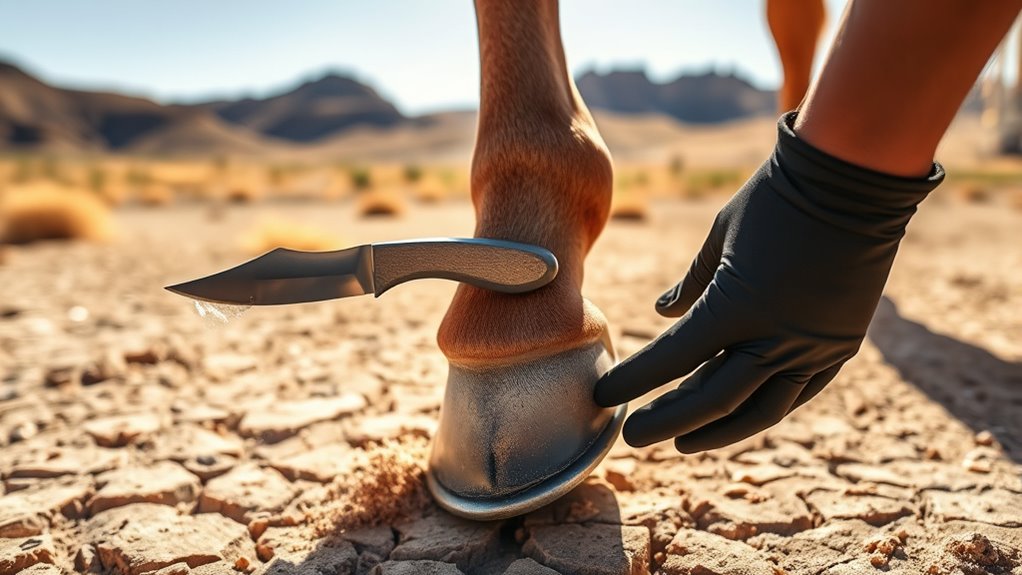
As temperatures rise and daylight hours lengthen, it’s essential to adjust your horse’s turnout and exercise routines for summer. Shorten exercise sessions during the hottest parts of the day to prevent overheating. Increase turnout during cooler mornings and evenings, providing shade when possible. Make seasonal feed adjustments by offering more electrolytes to replace lost minerals and reduce grain if your horse gains weight. Implement fly control strategies like fly masks, fans, and manure management to protect hooves from irritation. Here’s a quick guide:
| Routine Adjustment | Purpose |
|---|---|
| Turnout in early mornings or evenings | Avoid heat stress |
| Limit midday exercise | Prevent overheating |
| Use fly masks and fans | Reduce fly irritation on hooves |
| Increase electrolyte intake | Maintain hydration and health |
| Manage manure and pasture | Minimize fly breeding sites |
Frequently Asked Questions
How Can I Prevent Hoof Fungus in Dry Climates?
To prevent hoof fungus, you should focus on dry climate strategies like keeping your horse’s hooves clean and dry. Regularly inspect and pick out debris, and avoid overly moist areas. Use antifungal powders or sprays if needed, and guarantee proper hoof trimming to promote good airflow. Additionally, maintain a clean, dry environment and avoid sharing tack, which can spread infection. Consistent, proactive hoof fungus prevention keeps your horse healthy in dry conditions.
What Are the Best Supplements for Hoof Health in Summer?
Think of summer hoof care as nurturing a delicate garden—you need the right tools. The best hoof supplements for summer support healthy growth and strengthen hooves against dry conditions. Look for products with biotin, methionine, and zinc, which act like a shield for your horse’s hooves. Regularly incorporate these into your routine, and you’ll see stronger, more resilient hooves thriving through the heat and dryness of summer.
How Do Temperature Fluctuations Affect Hoof Care Routines?
Temperature fluctuations can considerably impact your hoof care routine. When temperatures change, your horse’s hoof moisture levels vary, making hooves more prone to cracking or becoming too dry. To prevent issues, you should regularly check and adjust your hoof care practices, like moisturizing or trimming, based on current conditions. This proactive approach helps maintain healthy hoof moisture and reduces the risk of hoof cracking during unpredictable temperature shifts.
Can Dehydration Impact Hoof Quality and Growth?
Dehydration can definitely impact hoof quality and growth, making your horse’s hooves brittle or prone to cracking. To prevent this, you should implement effective hydration strategies, ensuring your horse drinks enough water and maintains proper hoof moisture. Adequate hydration keeps the hooves strong and healthy, supporting steady growth. Regularly monitor your horse’s water intake and hoof condition, especially in dry climates where dehydration risks are higher.
What Signs Indicate My Horse Needs Professional Hoof Trimming Urgently?
If your horse’s hooves look like they’re about to fall apart, it’s a sign you need urgent professional trimming. Watch for hoof discoloration that resembles a rainbow gone wrong or sole cracking so severe it looks like dried riverbeds. These signs mean your horse’s hooves are begging for expert care before they turn into a hoof catastrophe. Don’t wait—your horse’s comfort and health depend on timely trimming!
Conclusion
By staying vigilant and adjusting your hoof care routine for hot, dry weather, you guarantee your horse’s hooves stay healthy and strong. Regular inspections, proper moisturization, and smart nutrition are key. Are you doing enough to protect your horse’s hooves from the harsh summer conditions? With consistent care and attention, you can keep your horse comfortable and sound all season long. Don’t wait until damage occurs—take action now for maximum hoof health.

